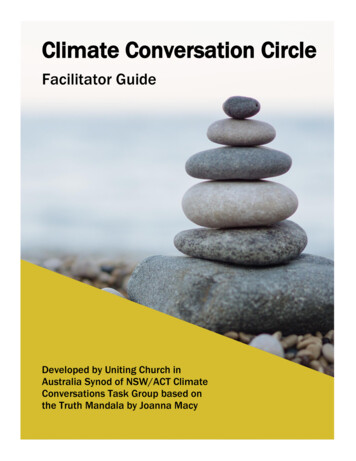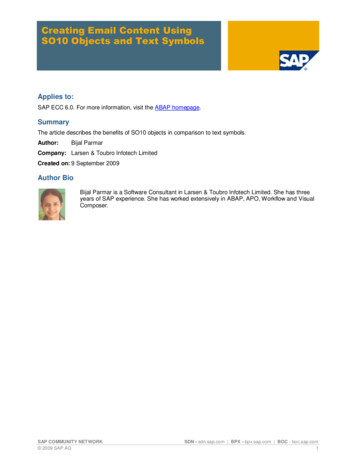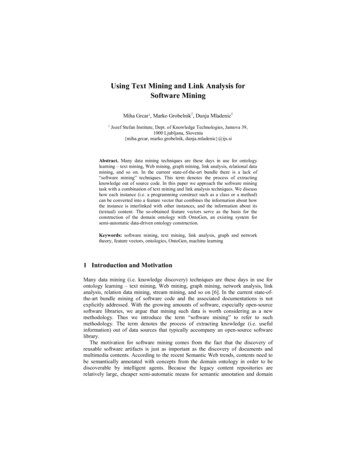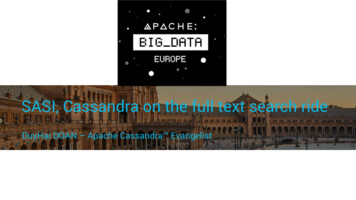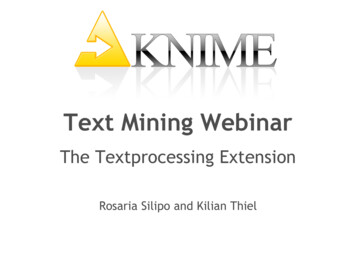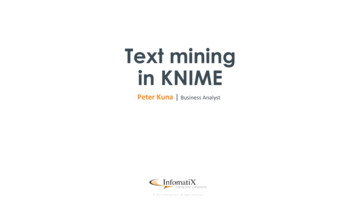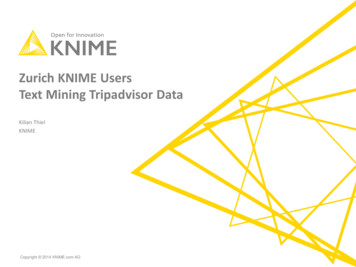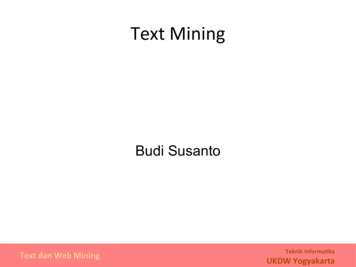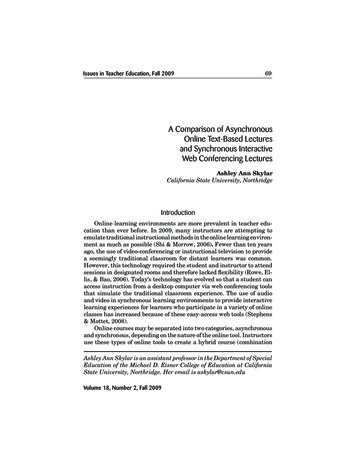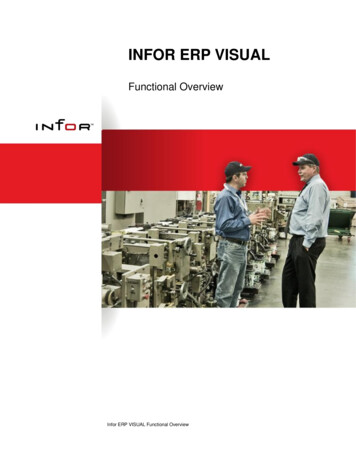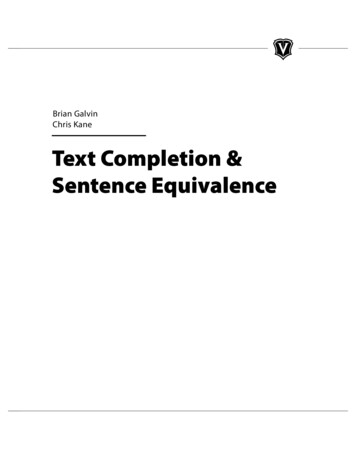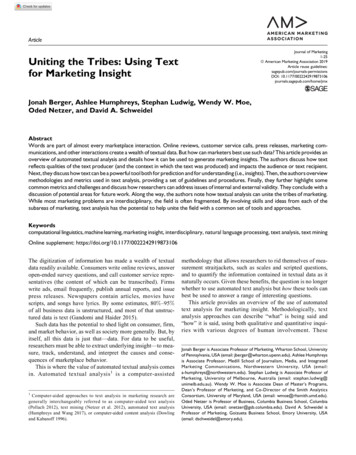
Transcription
ArticleJournal of Marketing1-25ª American Marketing Association 2019Article reuse guidelines:sagepub.com/journals-permissionsDOI: jmxUniting the Tribes: Using Textfor Marketing InsightJonah Berger, Ashlee Humphreys, Stephan Ludwig, Wendy W. Moe,Oded Netzer, and David A. SchweidelAbstractWords are part of almost every marketplace interaction. Online reviews, customer service calls, press releases, marketing communications, and other interactions create a wealth of textual data. But how can marketers best use such data? This article provides anoverview of automated textual analysis and details how it can be used to generate marketing insights. The authors discuss how textreflects qualities of the text producer (and the context in which the text was produced) and impacts the audience or text recipient.Next, they discuss how text can be a powerful tool both for prediction and for understanding (i.e., insights). Then, the authors overviewmethodologies and metrics used in text analysis, providing a set of guidelines and procedures. Finally, they further highlight somecommon metrics and challenges and discuss how researchers can address issues of internal and external validity. They conclude with adiscussion of potential areas for future work. Along the way, the authors note how textual analysis can unite the tribes of marketing.While most marketing problems are interdisciplinary, the field is often fragmented. By involving skills and ideas from each of thesubareas of marketing, text analysis has the potential to help unite the field with a common set of tools and approaches.Keywordscomputational linguistics, machine learning, marketing insight, interdisciplinary, natural language processing, text analysis, text miningOnline supplement: https://doi.org/10.1177/0022242919873106The digitization of information has made a wealth of textualdata readily available. Consumers write online reviews, answeropen-ended survey questions, and call customer service representatives (the content of which can be transcribed). Firmswrite ads, email frequently, publish annual reports, and issuepress releases. Newspapers contain articles, movies havescripts, and songs have lyrics. By some estimates, 80%–95%of all business data is unstructured, and most of that unstructured data is text (Gandomi and Haider 2015).Such data has the potential to shed light on consumer, firm,and market behavior, as well as society more generally. But, byitself, all this data is just that—data. For data to be useful,researchers must be able to extract underlying insight—to measure, track, understand, and interpret the causes and consequences of marketplace behavior.This is where the value of automated textual analysis comesin. Automated textual analysis 1 is a computer-assisted1Computer-aided approaches to text analysis in marketing research aregenerally interchangeably referred to as computer-aided text analysis(Pollach 2012), text mining (Netzer et al. 2012), automated text analysis(Humphreys and Wang 2017), or computer-aided content analysis (Dowlingand Kabanoff 1996).methodology that allows researchers to rid themselves of measurement straitjackets, such as scales and scripted questions,and to quantify the information contained in textual data as itnaturally occurs. Given these benefits, the question is no longerwhether to use automated text analysis but how these tools canbest be used to answer a range of interesting questions.This article provides an overview of the use of automatedtext analysis for marketing insight. Methodologically, textanalysis approaches can describe “what” is being said and“how” it is said, using both qualitative and quantitative inquiries with various degrees of human involvement. TheseJonah Berger is Associate Professor of Marketing, Wharton School, Universityof Pennsylvania, USA (email: jberger@wharton.upenn.edu). Ashlee Humphreysis Associate Professor, Medill School of Journalism, Media, and IntegratedMarketing Communications, Northwestern University, USA (email:a-humphreys@northwestern.edu). Stephan Ludwig is Associate Professor ofMarketing, University of Melbourne, Australia (email: stephan.ludwig@unimelb.edu.au). Wendy W. Moe is Associate Dean of Master’s Programs,Dean’s Professor of Marketing, and Co-Director of the Smith AnalyticsConsortium, University of Maryland, USA (email: wmoe@rhsmith.umd.edu).Oded Netzer is Professor of Business, Columbia Business School, ColumbiaUniversity, USA (email: onetzer@gsb.columbia.edu). David A. Schweidel isProfessor of Marketing, Goizueta Business School, Emory University, USA(email: dschweidel@emory.edu).
2approaches consider individual words and expressions, theirlinguistic relationships within a document (within-text interdependencies) and across documents (across-text interdependencies), and the more general topics discussed in the text.Techniques range from computerized word counting andapplying dictionaries to supervised or automated machinelearning that helps deduce psychometric and substantive properties of text.Within this emerging domain, we aim to make four maincontributions. First, we illustrate how text data can be used forboth prediction and understanding, to gain insight into whoproduced that text, as well as how that text may impact thepeople and organizations that consume it. Second, we provide ahow-to guide for those new to text analysis, detailing the maintools, pitfalls, and challenges that researchers may encounter.Third, we offer a set of expansive research propositions pertaining to using text as a means to understand meaning makingin markets with a focus on how customers, firms, and societiesconstrue or comprehend marketplace interactions, relationships, and themselves. Whereas previous treatments of textanalysis have looked specifically at consumer text (Humphreysand Wang 2017), social media communication (Kern et al.2016), or psychological processes (Tausczik and Pennebaker2010), we aim to provide a framework for incorporating textinto marketing research at the individual, firm, market, andsocietal levels. By necessity, our approach includes a wideranging set of textual data sources (e.g., user-generated content,annual reports, cultural artifacts, government text).Fourth, and most importantly, we discuss how text analysis canhelp “unite the tribes.” As a field, part of marketing’s value is itsinterdisciplinary nature. Unlike core disciplines such as psychology, sociology, or economics, the marketing discipline is a bigtent that allows researchers from different traditions and researchphilosophies (e.g., quantitative modeling, consumer behavior,strategy, consumer culture theory) to come together to studyrelated questions (Moorman et al. 2019a, b). In reality, however,the field often seems fragmented. Rather than different rowers allsimultaneously pulling together, it often feels more like separatetribes, each independently going off in separate directions.Although everyone is theoretically working toward similar goals,there tends to be more communication within groups thanbetween them. Different groups often speak different“languages” (e.g., psychology, sociology, anthropology, statistics, economics, organizational behavior) and use different tools,making it increasingly difficult to have a common conversation.However, text analysis can unite the tribes. Not only does itinvolve skills and ideas from each of these areas, doing it wellrequires such integration because it borrows ideas, concepts,approaches, and methods from each tribe and incorporates themto achieve insight. In so doing, the approach also adds value toeach of the tribes in ways that might not otherwise be possible.We start by discussing two distinctions that are useful whenthinking about how text can be used: (1) whether text reflects orimpacts (i.e., says something about the producer or has a downstream impact on something else) and (2) whether text is usedfor prediction or understanding (i.e., predicting something orJournal of Marketing XX(X)understanding what caused something). Next, we explain howtext may be used to unite the tribes of marketing. Then weprovide an overview of text analysis tools and methodologyand discuss key questions and measures of validity. Finally,we close with a future research agenda.The Universe of TextCommunication is an integral part of marketing. Not only dofirms communicate with customers, but customers communicate with firms and one another. Moreover, firms communicatewith investors and society communicates ideas and values tothe public (through newspapers and movies). These communications generate text or can be transcribed into text.A simple way to organize the world of textual data is tothink about producers and receivers—the person or organization that creates the text and the person or organizationwho consumes the text (Table 1). While there are certainlyother parties that could be listed, some of the mainproducers and receivers are consumers, firms, investors, andsociety at large. Consumers write online reviews that areread by other consumers, firms create annual reports thatare read by investors, and cultural producers represent societal meanings through the creation of books, movies, andother digital or physical artifacts that are consumed by individuals or organizations.Consistent with this distinction between text producer andtext receiver, researchers may choose to study how text reflectsor impacts. Specifically, text reflects information about, andthus can be used to gain insight into, the text producer or onecan study how text impacts the text receiver.Text as a Reflection of the ProducerText reflects and indicates something about the text producer(i.e., the person, organization, or context that created it). Customers, firms, and organizations use language to express themselves or achieve desired goals, and as a result, text signalsinformation about the actors, organization, or society that created it and the contexts in which it was created. Like an anthropologist piecing together pottery shards to learn about a distantcivilization, text provides a window into its producers.Take, for example, a social media post in which someonetalks about what they did that weekend. The text that personproduces provides insight into several facets. First, it providesinsight into the individual themselves. Are they introverted orextraverted? Neurotic or conscientious? It sheds light on whothey are in general (i.e., stable traits or customer segments;Moon and Kamakura 2017) as well as how they may be feelingor what they may be thinking at the moment (i.e., states). In asense, language can be viewed as a fingerprint or signature(Pennebaker 2011). Just like brush strokes or painting style canbe used to determine who painted a particular painting,researchers use words and linguistic style to infer whether aplay was written by Shakespeare, or if a person is depressed(Rude, Gortner, and Pennebaker 2004) or being deceitful
Berger et al.3Table 1. Text Producers and Receivers.TextProducersText ReceiversConsumersConsumers Online reviews (Anderson andSimester 2014; Chen and Lurie 2013;Fazio and Rockledge 2015a; Kronrodand Danziger 2013a; Lee and Bradlow2011; Liu, Lee, and Srinivasan 2019a;Melumad, Inman, and Pham 2019;Moon and Kamakura 2017; Puranam,Narayan, and Kadiyali 2017) Social media (Hamilton, Schlosser, andChen 2017a; Netzer et al. 2012;Villarroel Ordenes et al. 2017) Offline word of mouth (Berger andSchwartz 2011a; Mehl and Pennebaker2003a)FirmsFirmsInvestors Stock market reactions to Forms and applicationsconsumer text (Bollen,(Netzer, Lemaire, andMao, and Zeng 2011;Herzenstein 2019)Tirunillai and Tellis 2012) Idea-generation contexts(Bayus 2013a; Toubia and ProtestsNetzer 2017) Petitions Social media/brandcommunities (Herhausenet al. 2019) Consumer complaints(Ma, Baohung, and Kekre2015) Customer language onservice calls Tweeting at companies(Liu, Singh, and Srinivasan2016a) Crowdsourcingknowledge Letters to the editor Online commentssection Activism (e.g.,organizing politicalmovements andmarches) Financial reports Editorials by firm Owned media (e.g., company website Trade publications(Weber, Heinze, and(Loughran and McDonaldstakeholdersand social media; Villarroel OrdenesDeSoucey 2008a)2016)et al. 2018) Interviews withbusiness leaders Interfirm communication Corporate Advertisements (Fossen andemails (Ludwig et al.communications (Hobson,Schweidel 2017a, 2019; Liaukonyte,Teixeira, and Wilbur 2015a; Rosa et al.2016)Mayhew, and1999; Stewart and Furse 1986)Venkatachalam 2012) White papers Customer service agents (Packard and Chief executive officerBerger 2019; Packard, Moore, andletters to shareholdersMcFerran 2018)(Yadav, Prabhu, andChandy 2007 Packaging, including labels Text used in instructionsInvestors Letters to shareholders(Yadav, Prabhu, andChandy 2007) Shareholder feedback(Wies et al. 2019) Sector reportsInstitutions/ News content (Berger, Kim, and Business section Wall Street JournalsocietyMeyer 2019; Berger and Milkman Specialty magazines (e.g., FortuneWired, Harvard Business2012; Humphreys 2010) Various forms ofReview)investment advice that Movies (Berger, Moe, and Schweidelcome from media2019; Eliashberg, Hui, and Zhang 2007,2014; Toubia et al. 2019) Songs (Berger and Packard 2018;Packard and Berger 2019) Books (Akpinar and Berger 2015;Sorescu et al. 2018a)aInstitutions/Society Governmentdocuments, hearings,and memoranda(Chappell et al. 1997a) Forms of publicdialogue or debateReference appears in the Web Appendix.(Ludwig et al. 2016). The same is true for groups, organizations, or institutions. Language reflects something about whothey are and thus provides insight into what they might do inthe future.Second, text can provide insight into a person’s attitudestoward or relationships with other attitude objects—whetherthat person liked a movie or hated a hotel stay, for example,or whether they are friends or enemies with someone. Language used in loan applications provides insight into whetherpeople will default (Netzer, Lemaire, and Herzenstein 2019),language used in reviews can provide insight into whether theyare fake (Anderson and Simester 2014; Hancock et al. 2007;
4Ott, Cardie, and Hancock 2012), and language used by politicalcandidates could be used to study how they might govern in thefuture.These same approaches can also be used to understandleaders, organizations, or cultural elites through the text theyproduce. For example, the words a leader uses reflect whothey are as an individual, their leadership style, and theirattitudes toward various stakeholders. The language used inads, on websites, or by customer service agents reflects information about the company those pieces of text represent.Aspects such as brand personality (Opoku, Abratt, and Pitt2006), how much a firm is thinking about its customers (Packard and Berger 2019), or managers’ orientation toward endusers (Molner, Prabhu, and Yadav 2019) can be understoodthrough text. Annual reports provide insight into how well afirm is likely to perform in the future (Loughran and McDonald 2016).Yet beyond single individuals or organizations, text can alsobe aggregated across creators to study larger social groups orinstitutions. Given that texts reflect information about the people or organizations that created them, grouping people ororganizations together on the basis of shared characteristicscan provide insight into the nature of such groups and differences between them. Analyzing blog posts, for example, canshed light on how older and younger people view happinessdifferently (e.g., as excitement vs. peacefulness; Mogilner,Kamvar, and Aaker 2011). In a comparison of newspaper articles and press releases about different business sectors, text canbe used to understand the creation and spread of globalizationdiscourse (Fiss and Hirsch 2005). Customers’ language usefurther gives insight into the consumer sentiment in onlinebrand communities (Homburg, Ehm, and Artz 2015).More broadly, because texts are shaped by the contexts (e.g.,devices, cultures, time periods) in which they were produced,they also reflect information about these contexts. In the case ofculture, U.S. culture values high-arousal positive affectivestates more than East Asian cultures (Tsai 2007), and thesedifferences may show up in the language these different groupsuse. Similarly, whereas members of individualist cultures tendto use first-person pronouns (e.g., “I”), members of collectivistcultures tend to use a greater proportion of third-person pronouns (e.g., “we”).Across time, researchers were able to examine whether thenational mood changed after the September 11 attacks bystudying linguistic markers of psychological change in onlinediaries (Cohn, Mehl, and Pennebaker 2004). The languageused in news articles, songs, and public discourse reflectssocietal attitudes and norms, and thus analyzing changes overtime can provide insight into aspects such as attitudes towardwomen and minorities (Boghrati and Berger 2019; Garg et al.2018) or certain industries (Humphreys 2010). Journal articlesprovide a window into the evolution of topics within academia (Hill and Carley 1999). Books and movies serve as similar cultural barometers and could be used to shed light oneverything from cultural differences in customs to changes invalues over time.Journal of Marketing XX(X)Consequently, text analysis can provide insights that maynot be easily (or cost-effectively) obtainable through othermethods. Companies and organizations can use social listening(e.g., online reviews and blog posts) to understand whetherconsumers like a new product, how customers feel about theirbrand, what attributes are relevant for decision making, or whatother brands fall in the same consideration set (Lee and Bradlow 2011; Netzer et al. 2012). Regulatory agencies can determine adverse reactions to pharmaceutical drugs (Feldman et al.2015; Netzer et al. 2012), public health officials can gauge howbad the flu will be this year and where it will hit the hardest(Alessa and Faezipour 2018), and investors can try to predictthe performance of the stock market (Bollen, Mao, and Zeng2011; Tirunillai and Tellis 2012).Text’s Impact on ReceiversIn addition to reflecting information about the people, organizations, or society that created it, text also impacts or shapes theattitudes, behavior, and choices of the audience that consumesit. For example, take the language used by a customer serviceagent. While that language certainly reflects something aboutthat agent (e.g., their personality, how they are feeling thatday), how they feel toward the customer, and what type ofbrand they represent, that language also impacts the customerwho receives it (Packard and Berger 2019; Packard, Moore,and McFerran 2018). It can change customer attitudes towardthe brand, influence future purchase, or affect whether customers talk about the interaction with their friends. In that sense,language has a meaningful and measurable impact on theworld. It has consequences.This can be seen in a myriad of different contexts. Ad copyshapes customers’ purchase behavior (Stewart and Furse1986), newspaper language changes customers’ attitudes(Humphreys and LaTour 2013), trade publications and consumer magazines shift product category perceptions (e.g.,Rosa et al. 1999), movie scripts shape audience reactions(Berger, Kim, and Meyer 2019; Eliashberg, Hui, and Zhang2014; Reagan et al. 2016), and song lyrics shape song marketsuccess (Berger and Packard 2018; Packard and Berger 2019).The language used in political debates shapes which topics getattention (Berman et al. 2019), the language used in conversation shapes interpersonal attitudes (Huang et al. 2017), and thelanguage used in news articles shapes whether people read(Berger, Moe, and Schweidel, 2019b) or share (Berger andMilkman 2012) them.Firms’ language cho
1 Computer-aided approaches to text analysis in marketing research are generally interchangeably referred to as computer-aided text analysis (Pollach 2012), text mining (Netzer et al. 2012), automated text analysis (Humphreys and Wang 2017), or computer-aided content analys
